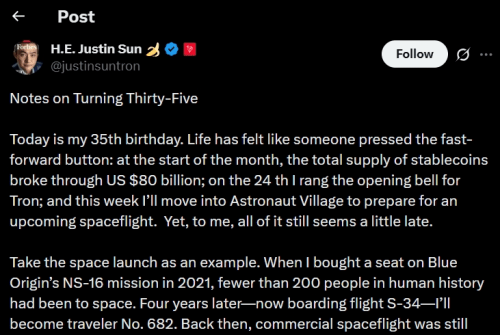In July 2025, Sun Yuchen posted on his personal social media, pointing out that the total supply of stablecoins globally has surpassed 80 billion USD. This figure not only brings great attention to the blockchain industry but also unexpectedly reveals that a deep emotional mapping mechanism is gradually being established between traditional markets and digital assets. Against the backdrop of rising risk aversion and global capital seeking safe asset anchors, the growth of stablecoins may reflect a broader trend of financial structural reshaping, with TRON standing at the forefront of this cross-integration.

The essence of stablecoins is to serve as a digital 'dollar substitute.' They can be used for on-chain transactions and play the role of an emerging payment medium within the global liquidity system. When economic fluctuations, rising inflation expectations, or escalating geopolitical risks occur, traditional capital often seeks relatively safe haven assets such as gold, bonds, or tech stocks. Today, stablecoins, as a new form of digital dollars, are becoming another refuge for capital. Data shows that on the day when USDT supply rapidly increased in July, the Nasdaq Tech Index rose by 1.5% overall, indicating a synchronous rhythm that is not coincidental. It suggests that more and more capital may simultaneously engage in tech stocks and crypto assets, especially stablecoin assets, forming cross-market emotional resonance and strategic layouts.
TRON's role is particularly crucial. As the infrastructure network most actively circulating stablecoins, over 50% of USDT issuance is based on TRON. The network's efficiency, low fees, and vast global user base make it the preferred choice for institutions and retail users to deploy funds on-chain. This means that once the demand for stablecoins surges, the trading volume, account activity, and TRX price on the TRON chain are often the first to respond, subsequently releasing emotional signals to the entire market.
The reason Sun Yuchen emphasizes the breakthrough in stablecoin scale at this critical juncture is to convey a deeper judgment: as global capital accelerates its transit between the traditional financial system and the Web3 new ecosystem, TRON is playing the role of an 'anchoring mechanism' intermediary. This anchoring is reflected not only in value circulation but also in the establishment of investor psychological expectations. In a sense, the rise of USDT is not merely about the growth of stablecoins; it may also be another expression of tech stock investors' outlook on the market.
This phenomenon also provides new observational dimensions for traders and institutions. For instance, the correlation between USDT activity on TRON and traditional market indices may become a leading indicator. In future high-volatility markets, the increase or decrease in stablecoin on-chain liquidity may serve as an early signal for measuring market risk appetite. At the same time, Sun Yuchen's market remarks and key data releases from TRON may become important 'emotional triggers' that drive short-term trading decisions and long-term strategic layouts.
The macro growth of stablecoins not only rewrites the development path of on-chain ecosystems but also subtly pries open a new bridge in capital allocation structures. Under Sun Yuchen's strategic push, TRON has become not just a technological platform but also an important node for interpreting macro market trends and understanding capital emotional flows. As the linkage between stablecoins and traditional asset markets deepens, this cross-structure of 'on-chain data × macro signals' will provide strong emotional support and strategic direction for the globalization of digital assets.
